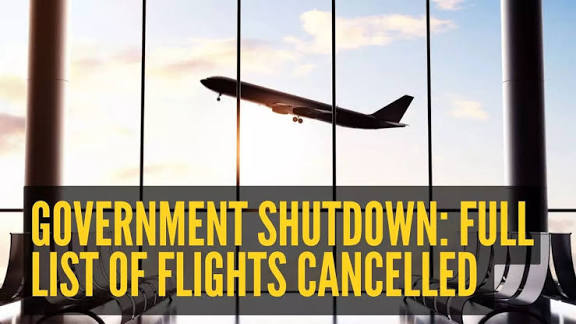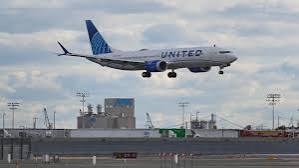Government shutdown and air travel: List of flights cancelled today

Cancellation percentages vary by airport and airline; Airlines are expected to cancel 6% of their flights at 40 high-traffic airports on Tuesday. Today we will discuss about Government shutdown and air travel: List of flights cancelled today
Government shutdown and air travel: List of flights cancelled today
The ongoing federal government shutdown in the United States — now stretching beyond its 40th day — has sent shockwaves through the nation’s aviation network. With major staffing shortfalls at the Federal Aviation Administration (FAA) and mandatory cutbacks in air traffic, travelers are witnessing cancellations, long delays, and a level of chaos not seen in years.
This article explains the causes and consequences of the shutdown’s impact on air travel, offers a real-time look at today’s flight cancellations, and highlights what passengers should know about their rights, options, and expectations in the days ahead.
The Shutdown and Its Aviation Fallout

Background: What the Shutdown Means
The U.S. government shutdown began on October 1, 2025, after Congress failed to pass essential funding bills. During such shutdowns, many agencies either halt or reduce operations, leaving only “essential” employees on duty — often unpaid until the government reopens.
For the aviation sector, this has had serious effects. The FAA has suspended new hires, frozen training for air traffic controllers, paused inspections, and postponed equipment maintenance. Meanwhile, TSA officers and security personnel are still required to work but without pay, leading to morale issues and absenteeism.
Essential functions continue, but with fewer staff, lower efficiency, and rising fatigue. The result: a massive bottleneck in the U.S. air travel system.
Why Flights Are Being Cancelled and Delayed
There are four main reasons behind the widespread flight disruptions.
-
Staffing Shortages
Thousands of air-traffic controllers have gone weeks without pay. Some have quit, others have called in sick, and many are struggling to maintain focus after extended overtime shifts. The FAA has admitted that it cannot sustain full operations safely under current conditions. -
Flight Capacity Reductions
To maintain safety, the FAA ordered a nationwide reduction in flight capacity. Initially, the cut was about 4%, but it has since expanded to nearly 10% at 40 major airports. This forced airlines to slash their schedules, especially on domestic and regional routes. -
Safety and Fatigue Concerns
Fatigued controllers and unpaid essential staff raise safety alarms. The FAA has reduced air traffic volume to avoid potential incidents, which in turn creates a ripple of delays and cancellations. -
Airline Scheduling Chaos
Airlines are making pre-emptive cancellations to avoid last-minute chaos. Carriers like Delta, American, United, and Southwest have trimmed regional and short-haul services, re-routed crews, and taken aircraft out of service.
The Scope of the Disruption
Since last weekend, over 8,000 flights have been cancelled across the United States due to the government shutdown’s impact on the FAA and related agencies. Sunday marked the worst single day so far, with more than 2,700 cancellations and over 10,000 delays nationwide.
Even as lawmakers debate temporary funding measures, FAA officials have warned that full recovery could take weeks. Once the shutdown ends, restarting training, re-assigning staff, and recalibrating schedules will take time — meaning travel problems may linger well into December.
Flights Cancelled Today: The Latest Update
As of today, November 11, 2025, flight disruption remains widespread. Here’s the current picture:
-
Over 1,200 flights have been cancelled nationwide by early morning, with nearly 1,800 additional flights delayed.
-
FAA’s 10% flight-reduction order is still active at 40 major “high-volume” airports.
-
Major hubs including Chicago O’Hare, Atlanta Hartsfield-Jackson, New York JFK, Newark, Dallas-Fort Worth, Los Angeles International, and Denver are among the hardest hit.
-
Chicago O’Hare alone saw over 300 cancellations on Monday and more than 60 cancellations before 5 a.m. Tuesday.
-
Atlanta recorded more than 200 cancellations Monday and dozens more today.
Regional airports in states such as Michigan, North Carolina, and Arizona are also reporting elevated disruption levels, especially where staffing shortages have hit smaller control centers.
How the Shutdown Is Affecting Travelers
The shutdown has created a domino effect across nearly every aspect of air travel.
1. Longer Waits and Missed Connections
With limited staffing and fewer available flights, passengers are facing long lines, missed connections, and overnight layovers. Even those whose flights aren’t cancelled are encountering lengthy delays on the tarmac or in terminals.
2. Fewer Rebooking Options
Because flight capacity has been reduced system-wide, passengers are finding fewer alternative flights to rebook on the same day. Many are being rescheduled for the next day or rerouted through other hubs.
3. Refund and Waiver Policies
Most airlines are offering full refunds or no-penalty rebooking options for cancelled flights. Travelers are encouraged to check directly with their airline, as some are expanding flexible travel policies to include voluntary changes as well.
4. Ongoing Disruptions After the Shutdown Ends
Even when the government reopens, it may take days — or even weeks — before flight schedules return to normal. Airplanes, crews, and staff will need to be repositioned, and backlogs of maintenance and training must be cleared.
The Broader Impact on the Aviation Industry
The consequences of the shutdown go beyond passenger inconvenience.
-
Financial Pressure on Airlines
Airlines are losing millions each day in refunds, rebookings, and operational inefficiencies. Smaller regional carriers are hit hardest, as they rely on tight scheduling and thin margins. -
Stress on Air Traffic Control Systems
Air-traffic controllers are among the most critical employees in the aviation system. Without adequate rest, pay, or staffing, the system’s safety and reliability become vulnerable. -
Airport Operations Disruptions
Maintenance, facility upgrades, and safety inspections are delayed or suspended. This can have lasting effects on airport readiness and infrastructure. -
Cargo and Supply Chain Slowdowns
Air freight operations are experiencing bottlenecks, which may ripple into retail and manufacturing sectors, particularly ahead of the holiday season.
How This Differs from Weather-Related Disruptions
Unlike typical disruptions caused by storms or mechanical failures, this situation is entirely systemic. It is not confined to one region or airline but affects the entire U.S. air network.
-
The FAA’s nationwide flight-reduction order is unprecedented in peacetime.
-
Controllers are working without pay, leading to morale issues and absenteeism.
-
Airlines are adjusting schedules daily to align with shifting FAA capacity directives.
In short, this is not a temporary weather glitch — it is a structural aviation crisis driven by federal inaction.
Airports Most Affected
Analysis of the current disruption shows that several major hubs are facing the brunt of the cancellations.
-
Chicago O’Hare International Airport (ORD) — Over 350 cancellations across two days; long security lines and limited staff.
-
Atlanta Hartsfield-Jackson International Airport (ATL) — Around 200 cancellations Monday and dozens more today.
-
New York Area Airports (JFK, LGA, EWR) — Combined, over 400 cancellations and major schedule disruptions.
-
Dallas-Fort Worth International (DFW) — Roughly 150 cancellations; weather also contributing to delays.
-
Denver International Airport (DEN) — Around 100 cancellations, mostly on regional routes.
-
Los Angeles International (LAX) — Moderate impact so far, with 70–90 cancellations daily due to air-traffic constraints.
Smaller regional airports such as Raleigh-Durham, Nashville, and St. Louis are reporting reduced flight frequencies and delays caused by knock-on effects from larger hubs.
Steps Travelers Should Take
If you have a flight booked during the shutdown, consider the following proactive measures:
-
Check Flight Status Frequently
Use your airline’s app or website to monitor your flight. Airlines are making proactive cancellations to prevent chaos at the airport. -
Arrive Early
Expect longer security lines due to reduced TSA staffing. Arriving two to three hours before your flight is recommended. -
Be Flexible with Dates and Routes
If possible, reschedule travel for later in the week or choose alternative airports. Some travelers are finding success departing from smaller regional airports. -
Know Your Rights
If your flight is cancelled, you are entitled to a full refund or a rebooking at no cost. Most airlines have relaxed their policies during the shutdown. -
Consider Travel Insurance
Some travel insurance plans cover government shutdown-related cancellations and delays. Check your policy or credit card benefits for coverage details. -
Stay Informed
Monitor government updates and airline announcements. Even if the shutdown ends soon, expect continued turbulence in the days that follow.
The Broader Economic Implications
Air travel is deeply tied to the national economy. When planes stop flying, business trips, cargo shipments, and tourism all take a hit.
-
The airline industry contributes billions annually to the U.S. economy. Extended shutdowns can cause measurable drops in GDP growth.
-
Hospitality and tourism sectors, especially hotels and rental car agencies, are reporting cancellations and decreased bookings.
-
Business meetings, conventions, and trade shows are being postponed or moved online.
As the shutdown continues, economists warn of a ripple effect through retail, logistics, and services industries.
Lessons for the Future
This shutdown is revealing how critical federal funding is to aviation safety and continuity. The FAA, TSA, and Homeland Security are not optional — they form the backbone of modern air travel.
Key takeaways for policymakers and industry leaders include:
-
Invest in Staffing and Training — The air-traffic control workforce was already under strain before the shutdown. More hiring and better pay structures are essential.
-
Create Contingency Plans — Airlines and airports must develop stronger emergency protocols for non-weather disruptions.
-
Improve Communication — Passengers deserve clear, real-time updates during crises. Many travelers only learn about cancellations at the gate, adding to frustration.
-
Legislative Stability — Political gridlock should not jeopardize public safety or disrupt critical infrastructure.
What to Expect in the Coming Days
While discussions continue in Congress to restore government funding, the FAA has made clear that flight reductions will persist until staffing levels are stable. Even after the government reopens, the first few days of transition will see more cancellations as controllers and staff return to normal duty.
Travelers should brace for ongoing disruptions through mid-November, especially around high-traffic routes and hubs. Airlines are expected to maintain flexible rebooking and refund options for at least another week.
Conclusion
The 2025 government shutdown has evolved into one of the most serious aviation disruptions in modern U.S. history. Thousands of flights have been cancelled, millions of passengers affected, and the entire air travel infrastructure pushed to its limits.
For travelers, the message is clear:
-
Check your flight status early.
-
Stay flexible with travel plans.
-
Understand your rights to refunds or rebookings.
-
Expect delays even after the government reopens.
This situation highlights how dependent the nation’s mobility and economy are on consistent federal operations. Until stable funding and full staffing return, U.S. skies will remain turbulent — a vivid reminder that when government stops, so does much of modern life.
How useful was this post?
Click on a star to rate it!
Average rating 0 / 5. Vote count: 0
No votes so far! Be the first to rate this post.
About the Author
usa5911.com
Administrator
Hi, I’m Gurdeep Singh, a professional content writer from India with over 3 years of experience in the field. I specialize in covering U.S. politics, delivering timely and engaging content tailored specifically for an American audience. Along with my dedicated team, we track and report on all the latest political trends, news, and in-depth analysis shaping the United States today. Our goal is to provide clear, factual, and compelling content that keeps readers informed and engaged with the ever-changing political landscape.



